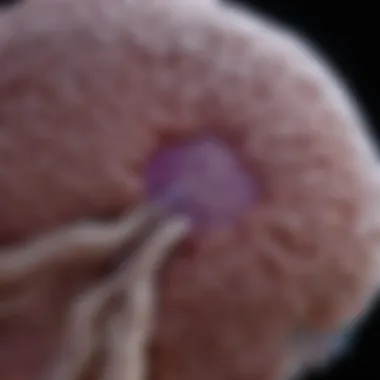Understanding DMG Brain Tumors: Comprehensive Insights


Intro
Diffuse midline gliomas (DMGs) represent a complex category of brain tumors that primarily affect the brainstem, thalamus, and spinal cord. Understanding these tumors is crucial for students, researchers, and healthcare professionals alike, as the biology and treatment approaches differ significantly from other brain tumors. The intricate nature of their genetic characteristics and the challenges they present in clinical management calls for a detailed exploration of their implications on patient outcomes and ongoing research efforts.
In this article, we will focus on essential concepts and terminologies related to DMGs, then delve into the findings that are influencing current practice and future investigations. Understanding the nuances of DMGs is vital for informing treatment strategies and enhancing the quality of life for patients afflicted with these tumors.
Prolusion to DMG Brain Tumors
Diffuse midline gliomas (DMGs) represent a challenging category of brain tumors, making understanding them essential for multiple stakeholders including medical professionals, researchers, and families affected by such conditions. The focus on DMGs is particularly relevant as these tumors exhibit distinct biological behaviors and pathophysiological complexities. The insights gained in this article will enhance both clinical practice and research efforts aimed at improving patient outcomes.
Defining DMG
Diffuse midline gliomas are highly aggressive brain tumors primarily seen in children and young adults. They usually arise in the midline structures of the brain, such as the pons, thalamus, and spinal cord. The tumors are characterized by their infiltrative growth patterns, which makes complete surgical resection challenging. DMGs are categorized as grade IV tumors according to the World Health Organization and are often referred to by their specific genetic characteristics, such as those associated with mutations in the K27M gene. These mutations significantly impact tumor behavior, response to treatment, and overall prognosis. Understanding these defining features is critical for accurate diagnosis and effective management.
Epidemiology and Incidence
The epidemiology of diffuse midline gliomas is notably complex. DMGs account for a small percentage of all brain tumors but their incidence has been increasing in recent years, drawing attention from medical professionals and researchers alike. Some key statistics include:
- Age Group: DMGs typically affect children between the ages of 5 and 15, although adults can be diagnosed as well.
- Gender Distribution: There is no strong gender predilection observed in the incidence of these tumors.
- Geographic Variation: Incidence rates can vary significantly across different regions and countries, often reflecting differences in diagnostic capabilities and healthcare systems.
"A thorough understanding of the epidemiological aspects of diffuse midline gliomas can aid in developing targeted interventions and policies aimed at early detection and treatment."
Pathophysiology of DMGs
Understanding the pathophysiology of diffuse midline gliomas (DMGs) is crucial in comprehending how these tumors develop, progress, and ultimately affect patient outcomes. DMGs are notorious for their aggressive nature and challenging management scenarios. They predominantly occur in children and are located in critical brain regions, making treatment more complex. An in-depth exploration of their cellular origins, histology, genetic factors, and biological behavior provides insights that can aid in diagnosis and treatment strategies.
Cellular Origins and Histology
DMGs arise from glial cells, which are the supporting cells in the central nervous system. More specifically, these tumors are thought to originate from progenitor cells of the pons, midbrain, or thalamus. The histological properties of DMGs typically reveal a high cellularity combined with a poorly defined tumor border. When studied under a microscope, these tumors exhibit characteristics such as high nuclear-to-cytoplasmic ratios, widespread necrosis, and significant mitotic activity. The presence of microvascular proliferation is also common in DMGs, thereby increasing the chances of edema and related symptoms.
The understanding of these cellular origins and histological patterns helps to not only visualize the tumor but also to create a relevant interaction between tumor biology and clinical symptoms. This relationship is pivotal because it helps oncologists to predict tumor behaviors and tailor management approaches more effectively.
Genetic Mutations and Biomarkers
Genetic mutations and biomarkers play a significant role in the pathophysiology of DMGs. Notably, mutations in the F3A gene, which codes for histone .3, are frequently observed. These mutations are believed to drive the tumorigenesis of DMGs by altering chromatin structure and function, leading to abnormal gene expression. Another important factor is the presence of p53 pathway alterations, which are common in various tumor types but are especially relevant in gliomagenesis.
The comprehensive identification of such mutations can lead to the development of more effective targeted therapies. For instance, molecular profiling of DMG tumors allows for the classification into subgroups that may respond differently to therapies. Key biomarkers can also serve as indicators for treatment response, helping to refine both current and emerging therapeutic strategies.
"The landscape of DMGs is continuously evolving, with genetic alterations impacting prognostic and therapeutic decisions."
In summary, understanding the pathophysiology of DMGs through their cellular origins, histological features, genetic mutations, and biomarkers is integral to improving clinical outcomes. The more that researchers and clinicians can learn about the biological behavior of these tumors, the better they can strategize treatment options and develop future therapies that hold the potential for improved survival rates and quality of life for patients.
Symptoms and Clinical Presentation
Understanding the symptoms and clinical presentation of diffuse midline gliomas (DMGs) plays a crucial role in the prompt identification and management of this disease. These tumors can manifest in various ways depending on their location within the brain. Recognizing these symptoms early can lead to more effective interventions. Common symptoms include cognitive and neurological changes as well as physical symptoms that patients may experience.
Cognitive and Neurological Symptoms
Cognitive and neurological symptoms of DMGs are often subtle in the initial stages but can progressively worsen. Patients may experience difficulties with memory, attention, and problem-solving. Changes in personality or behavior can also occur. These behaviors are not always easily attributed to a tumor, which complicates diagnosis.
Neurological deficits can manifest in motor skills and coordination. Patients might display weakness in one side of the body, have trouble with balance, or find simple tasks challenging. Seizures can occur as well, particularly for tumors in specific regions of the brain. As the tumor affects surrounding tissues, increased intracranial pressure may lead to further neurological symptoms, including headaches and visual disturbances.
Physical Symptoms
Physical symptoms associated with DMGs encompass a range of effects that can significantly impact a patient's quality of life. One of the most commonly reported physical symptoms is headaches, which may vary in intensity and frequency. They are often exacerbated by sudden movements or changes in posture.


Nausea and vomiting are also prevalent, particularly if the tumor is causing increased pressure in the cranial cavity. Some patients might notice changes in their coordination or experience dizziness, making everyday activities increasingly difficult.
"Understanding the physical symptoms of DMGs is essential for creating an effective treatment plan."
It is important to note that symptoms might vary among patients, depending on tumor size, location, and rate of growth. A thorough assessment by healthcare professionals is essential for determining the most appropriate diagnostic and therapeutic strategies for those affected by DMGs. A multidisciplinary approach often yields the best outcomes.
In summary, the symptoms and clinical presentation of DMGs encompass a combination of cognitive, neurological, and physical elements. Early recognition can significantly enhance patient management and overall prognosis.
Diagnostic Approaches
Diagnostic approaches for diffuse midline gliomas (DMGs) are critical in properly identifying and managing these complex tumors. Early and accurate diagnosis can significantly impact treatment decisions and patient outcomes. Several methods are used to diagnose DMGs, each contributing unique insights into the tumor's characteristics and behavior. Understanding these diagnostic tools not only helps clinicians in making informed choices but also equips patients and their families with knowledge about the steps involved in the diagnostic process.
Imaging Techniques
Magnetic Resonance Imaging
Magnetic Resonance Imaging (MRI) is commonly regarded as the gold standard for imaging DMGs. This technique employs strong magnetic fields and radio waves to produce detailed images of the brain. One of MRI’s key characteristics is its ability to provide contrast between different types of soft tissues. This feature is particularly beneficial in identifying the exact location, size, and extent of the tumor.
The unique aspect of MRI lies in its non-invasive nature and lack of ionizing radiation. This reduces the associated risks, making it suitable for repeated use in monitoring tumor progression or response to treatment. However, MRI can also present challenges. Some patients may experience anxiety or discomfort during scans. Moreover, it may not always provide conclusive results, necessitating additional diagnostic measures.
Computed Tomography
Computed Tomography (CT) scans use X-rays to create cross-sectional images of the body, including the brain. This technique is often employed when clinicians suspect an acute issue due to its speed and availability. The key characteristic of CT is its capacity to offer a quick overview of brain structure and identify larger masses or bleeding.
A unique feature of CT is its ability to be performed rapidly in emergency settings, making it invaluable for initial assessments. However, while CT is effective for detecting some issues, it often lacks the sensitivity and contrast resolution of MRI. The use of ionizing radiation also poses potential risks, particularly with repeated exposure.
Biopsy and Histopathological Examination
Biopsy is a definitive method to diagnose DMGs, allowing for direct examination of tumor tissue. This procedure can be performed during surgery or using less invasive techniques, such as stereotactic biopsy. Pathological examination is crucial as it provides specific insights into the tumor's cellular characteristics and helps in differentiating DMGs from other brain tumors.
Histopathological evaluation will reveal the cellular makeup of the tumor, which is essential for determining the appropriate treatment strategy. Effective diagnosis using biopsies not only aids in confirming the presence of DMGs but also informs on the aggressiveness and potential behavior of the tumor. Thus, the integration of imaging techniques and histopathological evaluation plays a profound role in the comprehensive diagnostic framework for DMGs.
Treatment Modalities
The discussion on treatment modalities for diffuse midline gliomas (DMGs) occupies a crucial position in the framework of understanding these tumors. Treatment approaches play a significant role in influencing patient outcomes and quality of life. DMGs, due to their highly invasive nature, pose a serious challenge in terms of effective management. A nuanced understanding of the various treatment options available is essential for tailoring individual patient care. Each treatment modality, whether surgical intervention, radiation therapy, chemotherapy, or emerging therapies, presents unique benefits and considerations that impact clinical decision-making.
Surgical Interventions
Surgical intervention is often considered the first line of attack against brain tumors, and DMGs are no exception. However, the complexity of surgical resection in DMGs is notable. These tumors frequently infiltrate critical areas of the brain, making complete removal exceptionally difficult. Thus, the primary goal of surgery is not only to remove as much of the tumor as possible but also to relieve symptoms caused by mass effect.
The extent of resection is generally linked to improved prognosis, but this must be weighed carefully against the risks of neurological deficits. Surgical techniques like neuronavigation and intraoperative imaging have improved the precision of these procedures, thus minimizing potential complications.
Radiation Therapy
Radiation therapy is a cornerstone in the treatment of DMGs, especially since these tumors often do not respond well to traditional chemotherapy. This therapy aims to destroy tumor cells and reduce tumor mass while simultaneously preserving surrounding healthy tissue.
The two most common forms of radiation treatment for DMGs are external beam radiation therapy and stereotactic radiosurgery. External beam radiation generally involves multiple sessions and is used post-operatively to target remaining cells. Stereotactic radiosurgery, on the other hand, can deliver a high dose of radiation to a focused area in a single session, which may benefit certain patients. Despite its effectiveness, the potential side effects such as fatigue and cognitive changes must be monitored closely.
Chemotherapy Approaches
Chemotherapy for DMGs has historically been limited in efficacy. However, several agents are currently being studied to enhance their effectiveness. The blood-brain barrier often presents a significant obstacle, limiting drug delivery to the tumor site.
Commonly used chemotherapeutic agents include temozolomide, which has shown modest improvements in survival. The approach often involves a combination of chemotherapy and radiation. Recent clinical trials have explored the role of novel agents and targeted therapy, driven by molecular characteristics of individual tumors. This personalized approach seeks to improve outcomes by focusing on specific genetic and molecular profiles.
Emerging Therapies


In recent years, the landscape of treatment for DMGs has expanded with emerging therapies. Concepts like immunotherapy and oncolytic virotherapy are gaining attention. These treatments aim to harness the body’s immune system to attack tumor cells and have shown promise in preliminary studies.
Furthermore, gene therapy and targeted therapies based on unique genetic mutations are in development. Ongoing trials continue to push the boundaries of what is possible, aiming to improve not only survival rates but also the quality of life for patients diagnosed with DMGs. As treatment strategies evolve, multidisciplinary collaboration among specialists becomes essential in managing these complex cases.
"The landscape of treatment for DMGs is rapidly changing, and continual research is necessary to improve patient outcomes."
Prognosis and Survival Rates
Understanding prognosis and survival rates is crucial when discussing diffuse midline gliomas (DMGs). These factors are not just numbers; they reflect a patient’s journey and provide insights into treatment approaches. Prognosis involves predicting the likely course and outcome of the disease. Consequently, survival rates indicate the percentage of people who survive a certain period after diagnosis. This information is invaluable for patients, families, and healthcare providers alike. It guides decision-making and prepares all involved for the future.
Factors Influencing Prognosis
Several factors impact the prognosis of patients diagnosed with DMGs. First, age plays a significant role. Children generally fare differently than adults, with some studies suggesting that younger patients often experience improved outcomes. Additionally, the extent of tumor resection during surgical intervention greatly affects prognosis. Radical surgeries may lead to better survival rates than those from minimal resection, depending on the tumor's location and invasiveness.
Genetic and molecular characteristics of the tumor also influence prognosis. Specific mutations, such as K27M, have been linked to more aggressive disease behavior. Better understanding these mutations can inform treatment strategies and provide clearer outlooks on patient survival.
Patient overall health status and pre-existing medical issues are additional vital considerations. Comorbid conditions can complicate treatment and potentially lower survival rates.
Statistical Outcomes
Statistical outcomes related to DMGs reveal the daunting nature of these tumors. Research indicates that median survival for patients can vary significantly, often ranging from 9 to 17 months following diagnosis. This variation stems from the previously mentioned factors influencing prognosis.
Studies have shown that approximately 20% of patients may survive beyond two years post-diagnosis. However, this statistic must be understood in context; survival can be heavily influenced by advances in treatment options and ongoing clinical trials.
Current data indicates:
- 5-year survival rate: Approximately 5%
- 1-year survival rate: Around 30%
These figures highlight the challenges faced by individuals diagnosed with DMGs, emphasizing the need for continued research and improved treatment methodologies.
Understanding these outcomes equips patients and families with the knowledge to make informed decisions.
The prognosis and survival rates of DMG patients remain a focal point in research, guiding studies aimed at enhancing patient care and developing new therapies. As ongoing investigations shed light on the variability of these tumors, hope for improved outcomes continues to grow.
Current Research and Future Directions
Research into diffuse midline gliomas (DMGs) remains a pivotal area in the field of neuro-oncology. Understanding the latest advancements not only sheds light on the biology of these complex tumors but also impacts clinical management significantly. Current research involves dissecting the genetic mechanisms driving DMGs, which can lead to novel treatment strategies that may improve prognosis. As researchers continue to uncover the intricacies surrounding DMGs, patients and families hope for more effective therapies and support systems.
Advancements in Genetic Research
Genetic research is at the forefront of developing new strategies for managing DMGs. The identification of specific genetic mutations and alterations presents opportunities for targeted therapies. Studies have highlighted the role of histone mutations, especially the K27M mutation, which is common in DMG patients. This mutation not only aids in diagnosis but also serves as a potential therapeutic target.
Furthermore, advancements in genomic sequencing technologies allow for a deeper understanding of the molecular landscape of DMGs. For instance, researchers can now analyze tumor genomes more comprehensively, enabling them to identify novel biomarkers that could predict treatment response. These biomarkers can help in tailoring personalized treatment plans for patients, increasing the likelihood of improved outcomes.
Collaboration between institutions has spurred initiatives aimed at establishing genetic databases tied to DMGs. These efforts not only facilitate research but also offer hope for new drug development based on identified genetic characteristics. Overall, the focus on genetic research can lead to breakthroughs in both diagnosis and therapy for DMGs, fundamentally changing how these tumors are approached clinically.
Innovative Treatment Strategies
As the understanding of DMGs evolves, so do the treatment strategies being explored. Traditional approaches such as surgery, radiation, and chemotherapy have not significantly improved outcomes for many patients. Consequently, researchers are investigating innovative treatment modalities that may enhance efficacy.
One promising area is the exploration of immunotherapy. This strategy seeks to harness the patient's own immune system to target and eliminate tumor cells. Clinical trials investigating checkpoint inhibitors, which have shown success in other tumor types, are currently underway. The hope is that by manipulating immune responses, patients with DMG can achieve better control over their disease.
In addition, other experimental therapies, including targeted therapies designed to attack specific pathways altered in DMGs, are being studied. For example, inhibitors that target the mTOR pathway are being evaluated due to their role in cell growth and survival.
Gene therapy is also an emerging strategy. Researchers are exploring ways to deliver therapeutic genes directly into tumor cells, thereby correcting genetic abnormalities associated with DMG.


"The success of these innovative strategies will depend heavily on ongoing clinical trials and collaboration among researchers and clinicians."
The integration of multidisciplinary care and comprehensive clinical trials is crucial to ensure that these innovative approaches are tested rigorously. By fostering innovation in treatment strategies, the future of DMG management may well see improved survival and quality of life for patients, which remains the ultimate goal for researchers in this field.
Multidisciplinary Approaches to Treatment
The landscape of diffuse midline gliomas (DMGs) treatment requires a multidimensional approach. This complexity stems from the tumors' aggressive nature and their location in critical areas of the brain. An integrated strategy is essential in order to optimize patient outcomes.
Role of Neurologists and Oncologists
Neurologists and oncologists play vital roles in the management of DMGs. Neurologists diagnose the condition, often interpreting imaging studies and conducting neurological examinations. Their job is to assess the impact of the tumor on neurological function and coordinate initial management strategies. After a diagnosis is confirmed, oncologists take over to devise a treatment plan. This typically combines surgery, radiation therapy, and chemotherapy.
Communication between these specialists is crucial. Regular meetings allow for discussion of the patient's condition and adjust treatment as necessary.
Integration of Support Services
Support services further enhance the treatment process for patients with DMGs. These services may include physical therapists, psychologists, and dietary specialists.
- Physical Therapy: Helps patients maintain mobility and strength throughout treatment.
- Psychological Support: Addresses the emotional and mental health challenges posed by diagnosis and treatment.
- Nutritional Counseling: Ensures that patients meet their dietary needs, which can be affected by both the disease and treatment side effects.
Good integration of these services can improve patients' quality of life. It provides a holistic support system that recognizes the physical, emotional, and psychological demands of battling DMGs.
"A multidisciplinary approach not only provides treatment but also fosters hope and resilience in patients and their families."
Impact on Patients and Families
The impact of diffuse midline gliomas (DMGs) extends far beyond the individual diagnosed with the tumor. It permeates families and the broader community, creating a ripple effect that underscores the need for comprehensive support systems. Understanding this impact is crucial not only for healthcare professionals but also for families navigating this challenging journey. This section elaborates on psychosocial considerations and support resources relevant to DMG patients and their families.
Psychosocial Considerations
Psychosocial factors play a pivotal role in shaping the experiences of patients with DMG and their families. Diagnosis often engenders a profound emotional response that can manifest as anxiety, depression, and social withdrawal. These emotional battles can complicate the treatment process and hinder recovery. Research indicates that mental health support is as critical as medical interventions for optimizing outcomes.
The following aspects are particularly relevant:
- Emotional Distress: Patients may experience fear about their future and uncertain treatment outcomes. This distress can reduce their quality of life.
- Family Dynamics: A diagnosis affects not only the patient but also family relationships. Caregivers may face stress related to managing care and their emotional well-being.
- Coping Mechanisms: Developing healthy coping strategies is essential. Access to psychological counseling helps patients and families process their experiences, leading to better emotional management.
Support groups and mental health professionals can provide invaluable assistance. These resources can help families feel less isolated and more empowered to handle their situations.
Support Networks and Resources
Access to support networks and resources is fundamental for families dealing with the challenges presented by DMG. These networks can range from local community groups to online forums where individuals share their experiences. The presence of strong support systems can alleviate some of the emotional burdens.
Key resources include:
- Community Organizations: Many local groups offer assistance, including counseling, financial aid, and informational resources. Organizations like the National Brain Tumor Society can provide guidance and referrals.
- Online Support Forums: Websites and platforms such as Reddit offer spaces for patients and families to connect, share stories, and exchange advice. These forums can create a sense of belonging.
- Educational Resources: Institutions like the American Brain Tumor Association provide valuable educational material about DMGs, which helps families make informed decisions regarding treatment options.
Connecting with these resources can significantly enhance the support infrastructure surrounding DMG patients and their families. Ultimately, a robust network of emotional, informational, and social support can foster resilience in facing the complexities of this condition.
Epilogue
The conclusion serves an essential function in this article. It synthesizes the content discussed throughout the different sections and emphasizes the importance of understanding diffuse midline gliomas (DMGs). DMGs represent a significant challenge within neuro-oncology due to their complex biological characteristics and characteristic treatment difficulties.
Summary of Key Points
Here, we summarize the main topics addressed in the article:
- Defining DMG: We explored the precise definition and classification of DMGs.
- Pathophysiology: The cellular origins and key genetic mutations contributing to these tumors were discussed.
- Symptoms: Key cognitive, neurological, and physical symptoms faced by patients were highlighted.
- Diagnostic Approaches: We covered imaging techniques including Magnetic Resonance Imaging and CT scans, alongside biopsy methods.
- Treatment Modalities: Discussion focused on surgical interventions, radiation therapy, chemotherapy, and emerging therapies.
- Prognosis: The article evaluated factors influencing prognosis and provided statistical outcomes.
- Current Research: Insights into advancements in research and potential future treatment strategies were examined.
- Patient Impact: We recognized the psychosocial impact on patients and their families, alongside the importance of support networks.
Final Thoughts on Future Research
Future research holds potential to significantly enhance the management of DMGs. As we understand more about the genetic and molecular underpinnings of these tumors, targeted therapies may become viable. Ongoing clinical trials are crucial for evaluating the efficacy of new treatment methodologies.
Moreover, interdisciplinary collaboration among researchers and clinicians will be vital in driving innovative approaches to both treatment and supportive care. The integration of advanced imaging techniques, precision medicine, and comprehensive care frameworks is projected to improve patient outcomes and quality of life.







